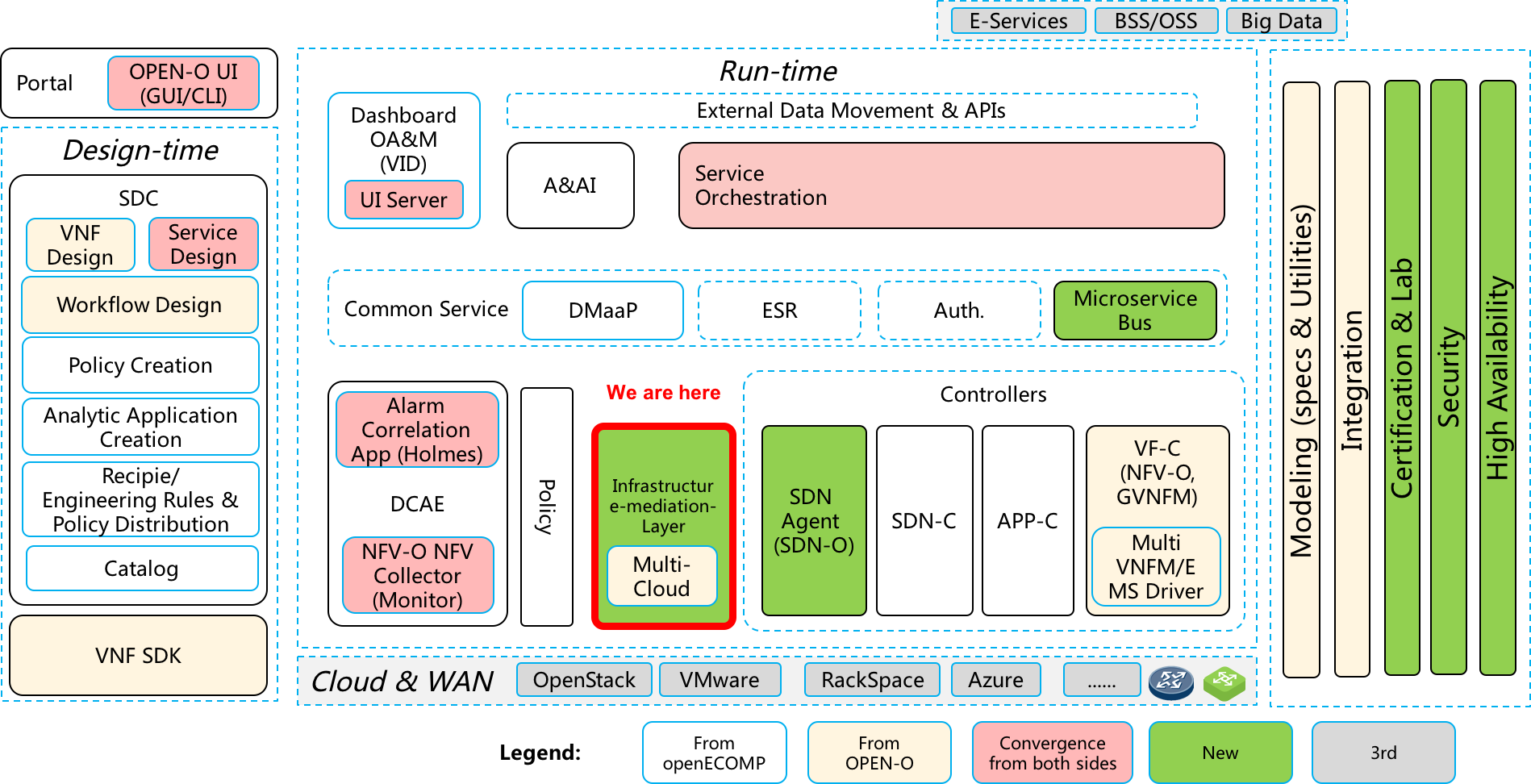...
- ONAP needs underlying virtualized infrastructure to deploy, run, and manage network services and VNFs. The service provider looks for flexibility in its choice of on-premise private cloud, public cloud, or hybrid cloud implementations, and related network backends. This project aims to enable ONAP to support multiple infrastructure environments, for example, OpenStack and its different distributions, public and private clouds (e.g., VMware, Azure etc.), and micro services containers, etc.
- ONAP needs to maintain platform backward compatibility with every new release. This project decouples the evolution of ONAP platform from the evolution of underlying cloud infrastructure and minimize the impact to enable the deployed ONAP intact when while upgrading the underlying cloud infrastructures.
...
- A plugable and extensible framework that
- provides a Mediation Layer which includes
- A common northbound interface (NBI) / Multi-Cloud APIs
- A common abstraction model
- The ability to handle differences in models
- The ability to generate or extend generates or extends NBI based on the functional model of underlying infrastructure
- allows Infrastructure Controller to register, discover and choose one or more VIM(s) to use
- allows global SDN Controller to choose and work with multiple local SDN Controller backends
- enables multiple local SDN Controller backends to interoperate collaboratively and simultaneously
- implements adapters for different providers.
- provides a Mediation Layer which includes
- Close loop remediation — Monitoring API collection for multi-cloud resource metrics (utilization, availability, health, performance), potential integration with DCAE collectors
- SDC VNF template customization and/or optimization to establish close match to the underline capabilities of the infrastructure provider(s)
- Should align with the Common Controller Framework to enable reuse by different ONAP elements.
...
In R1, we target to support
- Minimal
- Implementation of the adapters for VMware, OpenStack (Wind River), and Microsoft Azure.
- Demo use case within a single site, supported by any single VIM cloud provider.
- For vVoLTE or vCPE, enable single VIM cloud provider across multi-site site
- Stretch goal
- Implementation of the adapters for VMware VIO, OpenStack (Wind River), and Microsoft Azure.
- For vVoLTE or vCPE, enable mix of different VIM cloud providers across multi-site
...
The proposed Multi VIM/Cloud layer will be added into the infrastructure controller. It has dependencies with SO, DCAE, A&AI, APP-C/VNF-C, Modeling, and will act as the single access point to be called by these components for accessing the cloud and virtual infrastructure. Furthermore, it will align with SDN-C component for both intra DC connectivity as well as inter-DC connectivity. Thus it is also the single access point for SDN-C to work with other local SDN Controllers. Applications/VNFs can be homed to the different cloud providers through the standard ONAP methods. For automated homing (SNIRO), different cloud providers can register attributes that differentiate their cloud platforms (e.g., reliability, latency, other capabilities) in A&AI and application placement policies/constraints can request for these specific properties (e.g., reliability > 0.999).
What other ONAP projects does this project depend on?
Common Services, AAI, Modeling, SO, APP-C/VNF-C, DCAE, SDN-C
- How does this align with external standards/specifications?
- Support existed functions
- Information/data models by ONAP modeling project
- Compliant with ETSI NFV architecture framework
- This project aligns with ETSI NFV VIM and NFViVIM, NFVI, Nf-Vi, Vi-Vnfm, and Or-Vi
- Are there dependencies with other open source projects?
- OpenStack
Resources:
- Primary Contact Person
- Danny Lin, lind@vmware.com, VMware
- Names, emails, and company affiliations of the committers
Alon Strikovsky, alon.Strikovsky@amdocs.com, Amdocs
- Anbing Zhang, zhanganbing@chinamobile.com, China Mobile
- Andrew Philip, aphilip@microsoft.com, Microsoft
- Bin Hu, bh526r@att.com, AT&T
- Bin Yang, bin.yang@windriver.com, Wind River
- Kanagaraj Manickam (mkr1481), kanagaraj.manickam@huawei.com, Huawei
- Xinhui Li, lxinhui@vmware.com, VMware
- Names and affiliations of any other contributors
- Claude Noshpitz claude.noshpitz@att.com, AT&T
- Ethan Lynn, ethanlynnl@vmware.com, VMware
- Gil Hellmann, gil.hellmann@windriver.com, Wind River
- Isaku Yanahata, isaku.yamahata@intel.com, Intel
- Matti Hiltunen, hiltunen@att.com, AT&T
- John Murray, jm2932@att.com, AT&T
- Project Roles (include RACI chart, if applicable)
...
